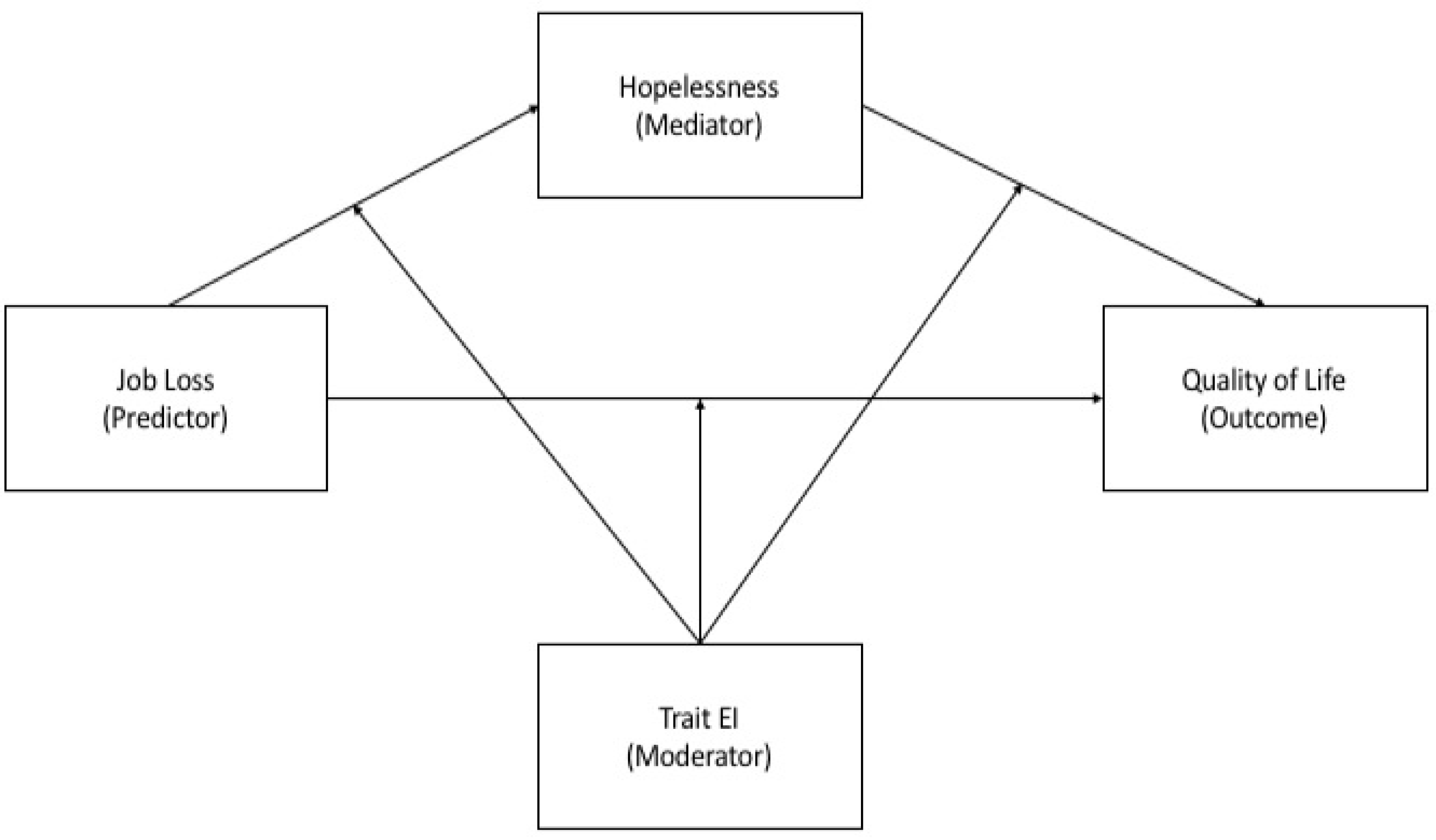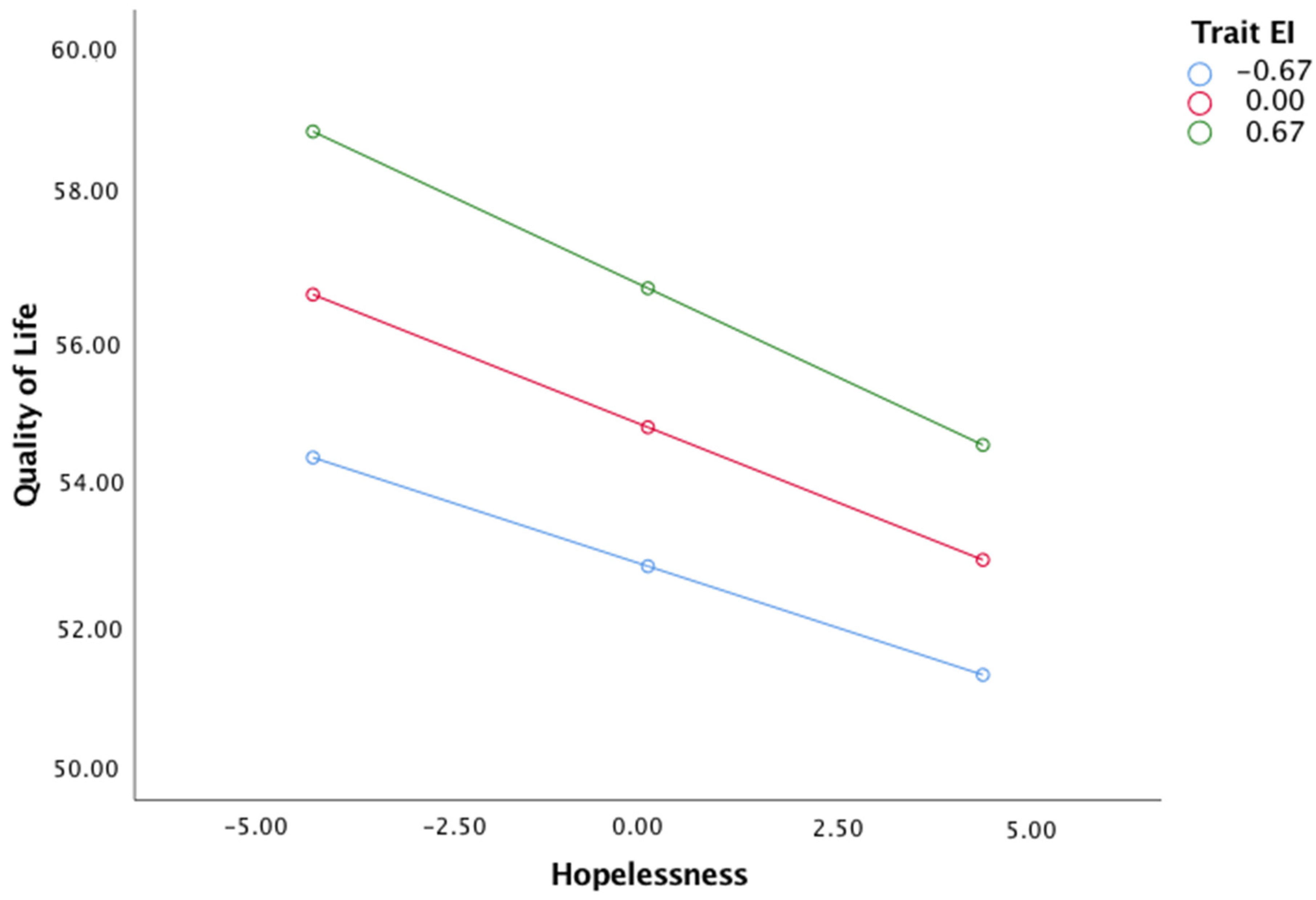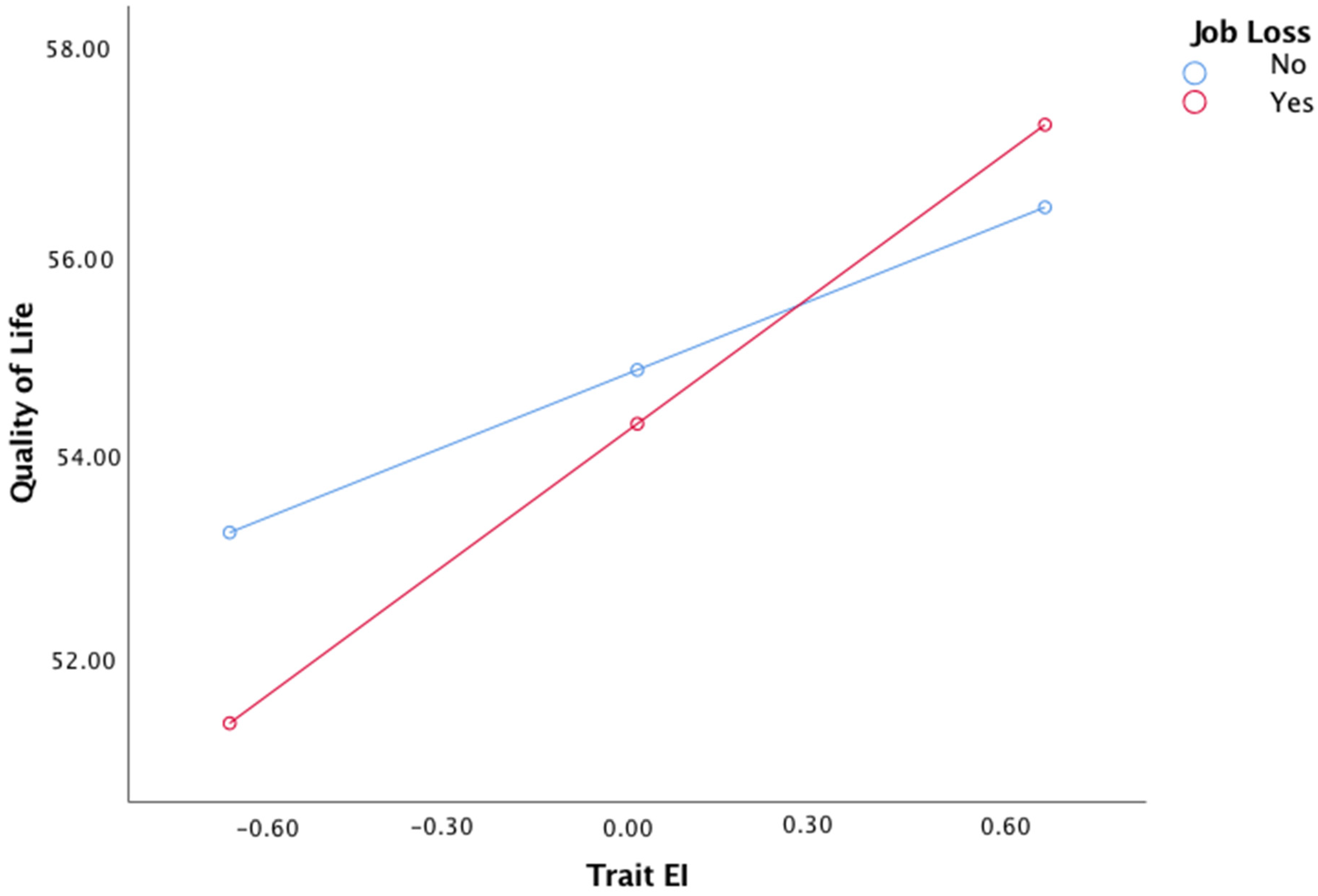Quality of Life and Job Loss during the COVID-19 Pandemic: Mediation by Hopelessness and Moderation by Trait Emotional Intelligence
Abstract
:1. Introduction
The Present Study
2. Materials and Methods
2.1. Participants
2.2. Instruments
2.3. Procedure
2.4. Statistical Analysis
3. Results
3.1. Testing for Hypothesis 1 and 2: Preliminary Analysis
3.2. Testing for Hypothesis 3: Mediating Role of Hopelessness
3.3. Testing for Hypothesis 4: Moderating Role of Trait EI
4. Discussion
5. Conclusions
Author Contributions
Funding
Institutional Review Board Statement
Informed Consent Statement
Data Availability Statement
Acknowledgments
Conflicts of Interest
References
- Brooks, S.K.; Webster, R.K.; Smith, L.E.; Woodland, L.; Wessely, S.; Greenberg, N.; Rubin, G.J. The psychological impact of quarantine and how to reduce it: Rapid review of the evidence. Lancet 2020, 395, 912–920. [Google Scholar] [CrossRef] [Green Version]
- Bueno-Notivol, J.; Gracia-García, P.; Olaya, B.; Lasheras, I.; López-Antón, R.; Santabárbara, J. Prevalence of depression during the COVID-19 outbreak: A meta-analysis of community-based studies. Int. J. Clin. Health Psychol. 2021, 21, 100196. [Google Scholar] [CrossRef]
- Epifanio, M.S.; Andrei, F.; Mancini, G.; Agostini, F.; Piombo, M.A.; Spicuzza, V.; Riolo, M.; Lavanco, G.; Trombini, E.; La Grutta, S. The Impact of COVID-19 Pandemic and Lockdown Measures on Quality of Life among Italian General Population. J. Clin. Med. 2021, 10, 289. [Google Scholar] [CrossRef] [PubMed]
- Qiu, J.; Shen, B.; Zhao, M.; Wang, Z.; Xie, B.; Xu, Y. A nationwide survey of psychological distress among Chinese people in the COVID-19 epidemic: Implications and policy recommendations. Gen. Psychiatry 2020, 33, e100213. [Google Scholar] [CrossRef] [PubMed] [Green Version]
- Kawohl, W.; Nordt, C. COVID-19, unemployment, and suicide. Lancet Psychiatry 2020, 7, 389–390. [Google Scholar] [CrossRef]
- Moen, P.; Pedtke, J.H.; Flood, S. Disparate Disruptions: Intersectional COVID-19 Employment Effects by Age, Gender, Education, and Race/Ethnicity. Work. Aging Retire. 2020, 6, 207–228. [Google Scholar] [CrossRef] [PubMed]
- Fana, M.; Pérez, S.T.; Fernandez-Macias, E. Employment impact of Covid-19 crisis: From short term effects to long terms prospects. J. Ind. Bus. Econ. 2020, 47, 391–410. [Google Scholar] [CrossRef]
- McDowell, C.P.; Herring, M.P.; Lansing, J.; Brower, C.S.; Meyer, J.D. Associations Between Employment Changes and Mental Health: US Data From During the COVID-19 Pandemic. Front. Psychol. 2021, 12, 631510. [Google Scholar] [CrossRef]
- Forte, G.; Favieri, F.; Tambelli, R.; Casagrande, M. The Enemy Which Sealed the World: Effects of COVID-19 Diffusion on the Psychological State of the Italian Population. J. Clin. Med. 2020, 9, 1802. [Google Scholar] [CrossRef] [PubMed]
- Gómez-Durán, E.L.; Martin-Fumadó, C.; Forero, C.G. Psychological impact of quarantine on healthcare workers. Occup. Environ. Med. 2020, 77, 666–674. [Google Scholar] [CrossRef]
- Medda, E.; Toccaceli, V.; Gigantesco, A.; Picardi, A.; Fagnani, C.; Stazi, M.A. The COVID-19 pandemic in Italy: Depressive symptoms immediately before and after the first lockdown. J. Affect. Disord. 2021, 298, 202–208. [Google Scholar] [CrossRef] [PubMed]
- Rossi, R.; Socci, V.; Talevi, D.; Mensi, S.; Niolu, C.; Pacitti, F.; Di Marco, A.; Rossi, A.; Siracusano, A.; Di Lorenzo, G. COVID-19 Pandemic and Lockdown Measures Impact on Mental Health Among the General Population in Italy. Front. Psychiatry 2020, 11, 790. [Google Scholar] [CrossRef] [PubMed]
- Pompili, M.; Innamorati, M.; Sampogna, G.; Albert, U.; Carmassi, C.; Carrà, G.; Cirulli, F.; Erbuto, D.; Luciano, M.; Nanni, M.G.; et al. The impact of Covid-19 on unemployment across Italy: Consequences for those affected by psychiatric conditions. J. Affect. Disord. 2021, 296, 59–66. [Google Scholar] [CrossRef] [PubMed]
- Beck, A.T.; Weissman, A.; Lester, D.; Trexler, L. The measurement of pessimism: The hopelessness scale. J. Consult. Clin. Psychol. 1974, 42, 861–865. [Google Scholar] [CrossRef]
- Soares, J.J.; Macassa, G.; Grossi, G.; Viitasara, E. Psychosocial correlates of hopelessness among men. Cogn. Behav. Ther. 2008, 37, 50–61. [Google Scholar] [CrossRef]
- Ravindran, O.S.; Shankar, A.; Murthy, T. A comparative study on perceived stress, coping, quality of life, and hopelessness between cancer patients and survivors. Indian J. Palliat. Care 2019, 25, 414–420. [Google Scholar] [CrossRef]
- Morselli, D. Contextual determinants of hopelessness: Investigating socioeconomic factors and emotional climates. Soc. Indic. Res. 2017, 133, 373–393. [Google Scholar] [CrossRef]
- Wheaton, B. Models for the stress-buffering functions of coping resources. J. Health Soc. Behav. 1985, 26, 352. [Google Scholar] [CrossRef]
- Cohen, S.; Edqards, J. Personality characteristics as moderators of the relationship between stress and disorder. In Advances in the Investigation of Psychological Stress; Neufeld, R., Ed.; Wiley: New York, NY, USA, 1989; pp. 235–283. Available online: https://www.scirp.org/(S(i43dyn45teexjx455qlt3d2q))/reference/ReferencesPapers.aspx?ReferenceID=1088531 (accessed on 31 March 2021).
- Lazarus, R.S.; Folkman, S. Stress, appraisal, and coping. Behav. Cogn. Psychother. 1984, 14, 345. [Google Scholar] [CrossRef]
- Bertuccio, R.F.; Runion, M.C. Considering grief in mental health outcomes of COVID-19. Psychol. Trauma: Theory Res. Pract. Policy 2020, 12, S87–S89. [Google Scholar] [CrossRef]
- Crayne, M.P. The traumatic impact of job loss and job search in the aftermath of COVID-19. Psychol. Trauma: Theory Res. Pract. Policy 2020, 12, S180–S182. [Google Scholar] [CrossRef]
- White, R.G.; Van Der Boor, C. Impact of the COVID-19 pandemic and initial period of lockdown on the mental health and well-being of adults in the UK. Br. J. Psychol. Open 2020, 6, e90. [Google Scholar] [CrossRef] [PubMed]
- Leiva-Bianchi, M.; Baher, G.; Poblete, C. The Effects of Stress Coping Strategies in Post-Traumatic Stress Symptoms Among Earthquake Survivors: An Explanatory Model of Post-Traumatic Stress. Terapia Psicológica 2012, 30, 51–59. [Google Scholar] [CrossRef]
- Schönfeld, P.; Brailovskaia, J.; Bieda, A.; Zhang, X.C.; Margraf, J. The effects of daily stress on positive and negative mental health: Mediation through self-efficacy. Int. J. Clin. Health Psychol. 2016, 16, 1–10. [Google Scholar] [CrossRef] [PubMed]
- Schutte, N.S.; MalouffJ, M.; Thorsteinsson, E.; Bhullar, N.; Rooke, S.E. A meta-analytic investigation of the relationship between emotional intelligence and health. Pers. Individ. Differ. 2007, 42, 921–933. [Google Scholar] [CrossRef]
- Zysberg, L. Emotional Intelligence and Health Outcomes. Psychology 2018, 09, 2471–2481. [Google Scholar] [CrossRef] [Green Version]
- Pellitteri, J. The relationship between emotional intelligence and ego defense mechanisms. J. Psychol. Interdiscip. Appl. 2002, 136, 182–194. [Google Scholar] [CrossRef]
- Zeidner, M.; Matthews, G.; Roberts, R.D. Emotional intelligence, coping with stress, and adaptation. In Emotional Intelligence in Everyday Life; Psychology Press: New York, NY, USA, 2006; pp. 100–125. [Google Scholar]
- Petrides, K.V.; Pita, R.; Kokkinaki, F. The location of trait emotional intelligence in personality factor space. Br. J. Psychol. 2007, 98, 273–289. [Google Scholar] [CrossRef] [Green Version]
- Andrei, F.; Mancini, G.; Baldaro, B.; Trombini, E.; Agnoli, S. A systematic review on the predictive utility of the Trait Emotional Intelligence Questionnaire (TEIQue). Appl. Psychol. Bull. 2014, 62, 2–29. [Google Scholar]
- Andrei, F.; Siegling, A.; Aloe, A.M.; Baldaro, B.; Petrides, K.V. The Incremental Validity of the Trait Emotional Intelligence Questionnaire (TEIQue): A Systematic Review and Meta-Analysis. J. Pers. Assess. 2016, 98, 261–276. [Google Scholar] [CrossRef] [Green Version]
- Petrides, K.V.; Mikolajczak, M.; Mavroveli, S.; Sanchez-Ruiz, M.-J.; Furnham, A.; Pérez-González, J.-C. Developments in Trait Emotional Intelligence Research. Emot. Rev. 2016, 8, 335–341. [Google Scholar] [CrossRef]
- Martins, A.; Ramalho, N.; Morin, E. A comprehensive meta-analysis of the relationship between Emotional Intelligence and health. Pers. Individ. Differ. 2010, 49, 554–564. [Google Scholar] [CrossRef]
- Mikolajczak, M.; Luminet, O. Trait emotional intelligence and the cognitive appraisal of stressful events: An exploratory study. Pers. Individ. Differ. 2008, 44, 1445–1453. [Google Scholar] [CrossRef]
- Moroń, M.; Biolik-Moroń, M. Trait emotional intelligence and emotional experiences during the COVID-19 pandemic outbreak in Poland: A daily diary study. Pers. Individ. Differ. 2021, 168, 110348. [Google Scholar] [CrossRef]
- Soto-Rubio, A.; Giménez-Espert, M.; Prado-Gascó, V. Effect of Emotional Intelligence and Psychosocial Risks on Burnout, Job Satisfaction, and Nurses’ Health during the COVID-19 Pandemic. Int. J. Environ. Res. Public Health 2020, 17, 7998. [Google Scholar] [CrossRef]
- Prentice, C.; Zeidan, S.; Wang, X. Personality, trait EI and coping with COVID 19 measures. Int. J. Disaster Risk Reduct. 2020, 51, 101789. [Google Scholar] [CrossRef]
- Zysberg, L.; Zisberg, A. Days of worry: Emotional intelligence and social support mediate worry in the COVID-19 pandemic. J. Health Psychol. 2020, 27, 268–277. [Google Scholar] [CrossRef]
- Ferrucci, R.; Averna, A.; Marino, D.; Reitano, M.R.; Ruggiero, F.; Mameli, F.; Dini, M.; Poletti, B.; Barbieri, S.; Priori, A.; et al. Psychological Impact During the First Outbreak of COVID-19 in Italy. Front. Psychiatry 2020, 11, 1118. [Google Scholar] [CrossRef]
- Mazza, C.; Ricci, E.; Biondi, S.; Colasanti, M.; Ferracuti, S.; Napoli, C.; Roma, P. A Nationwide Survey of Psychological Distress among Italian People during the COVID-19 Pandemic: Immediate Psychological Responses and Associated Factors. Int. J. Environ. Res. Public Health 2020, 17, 3165. [Google Scholar] [CrossRef]
- Solomou, I.; Constantinidou, F. Prevalence and Predictors of Anxiety and Depression Symptoms during the COVID-19 Pandemic and Compliance with Precautionary Measures: Age and Sex Matter. Int. J. Environ. Res. Public Health 2020, 17, 4924. [Google Scholar] [CrossRef]
- Wang, C.; Pan, R.; Wan, X.; Tan, Y.; Xu, L.; Ho, C.S.; Ho, R.C. Immediate Psychological Responses and Associated Factors during the Initial Stage of the 2019 Coronavirus Disease (COVID-19) Epidemic among the General Population in China. Int. J. Environ. Res. Public Health 2020, 17, 1729. [Google Scholar] [CrossRef] [Green Version]
- Zhang, Y.; Ma, Z.F. Impact of the COVID-19 Pandemic on Mental Health and Quality of Life among Local Residents in Liaoning Province, China: A Cross-Sectional Study. Int. J. Environ. Res. Public Health 2020, 17, 2381. [Google Scholar] [CrossRef] [Green Version]
- Yıldırım, M.; Arslan, G.; Özaslan, A. Perceived Risk and Mental Health Problems among Healthcare Professionals during COVID-19 Pandemic: Exploring the Mediating Effects of Resilience and Coronavirus Fear. Int. J. Ment. Health Addict. 2020, 1–11. [Google Scholar] [CrossRef]
- De Girolamo, G.; Rucci, P.; Scocco, P.; Becchi, A.; Coppa, F.; D’Addario, A.; Daru, E.; De Leo, D.; Galassi, L.; Mangelli, L.; et al. Quality of life assessment: Validation of the Italian version of the WHOQOL-Brief. Epidemiol. Psichiatr. Soc. 2000, 9, 45–55. [Google Scholar] [CrossRef]
- The Whoqol Group. The World Health Organization quality of life assessment (WHOQOL): Development and general psychometric properties. Soc. Sci. Med. 1998, 46, 1569–1585. [Google Scholar] [CrossRef]
- Petrides, K.V.; Furnham, A. Trait Emotional Intelligence Questionnaire (TEIQue); Technical Manual; London Psychometric Laboratory: London, UK, 2009; Available online: https://teique.com/ (accessed on 31 March 2021).
- IBM Corp. Released 2017. IBM SPSS Statistics for Windows, Version 25.0. IBM Corp: Armonk, NY, USA. Available online: https://www.ibm.com/support/pages/how-cite-ibm-spss-statistics-or-earlier-versions-spss (accessed on 31 March 2021).
- Hayes, A.F. Introduction to Mediation, Moderation, and Conditional Process Analysis: A Regression-Based Approach, 2nd ed.; Methodology in the social sciences; Guilford Press: New York, NY, USA, 2018; p. 692. ISBN 978-1-4625-3465-4. [Google Scholar]
- MacKinnon, D.P.; Lockwood, C.M.; Hoffman, J.M.; West, S.G.; Sheets, V. A comparison of methods to test mediation and other intervening variable effects. Psychol. Methods 2002, 7, 83–104. [Google Scholar] [CrossRef]
- Cohen, P.; West, S.G.; Aiken, L.S. Applied Multiple Regression/Correlation Analysis for the Behavioral Sciences; Psychology Press: East Sussex, UK, 2014. [Google Scholar] [CrossRef]
- Zhu, Y.; Zhang, L.; Zhou, X.; Li, C.; Yang, D. The impact of social distancing during COVID-19: A conditional process model of negative emotions, alienation, affective disorders, and post-traumatic stress disorder. J. Affect. Disord. 2021, 281, 131–137. [Google Scholar] [CrossRef]
- Hostinar, C.E.; Gunnar, M.R. Social Support Can Buffer Against Stress and Shape Brain Activity. AJOB Neurosci. 2015, 6, 34–42. [Google Scholar] [CrossRef]
- Mérida-López, S.; Extremera, N.; Quintana-Orts, C.; Rey, L. Does Emotional Intelligence Matter in Tough Times? A Moderated Mediation Model for Explaining Health and Suicide Risk amongst Short- and Long-Term Unemployed Adults. J. Clin. Med. 2019, 8, 797. [Google Scholar] [CrossRef] [Green Version]
- World Health Organization. Regional Office for Europe. Pandemic Fatigue: Reinvigorating the Public to Prevent COVID-19: Policy Framework for Supporting Pandemic Prevention and Management: Revised Version November 2020. World Health Organization. Regional Office for Europe. 2020. Available online: https://apps.who.int/iris/handle/10665/337574 (accessed on 31 March 2021).
- Stoddard, M.; Van Egeren, D.; Johnson, K.; Rao, S.; Furgeson, J.; White, D.E.; Nolan, R.P.; Hochberg, N.; Chakravarty, A. Model-based evaluation of the impact of noncompliance with public health measures on COVID-19 disease control. Medrxiv 2020. Available online: http://medrxiv.org/content/early/2020/12/02/2020.11.29.20240440.abstract (accessed on 31 March 2021).
- Wiederhold, E.-I.-C.B.K. Social Media Use During Social Distancing. Cyberpsychology Behav. Soc. Netw. 2020, 23, 275–276. [Google Scholar] [CrossRef] [Green Version]
- Vaterlaus, J.M.; Spruance, L.A.; Patten, E.V. Social Media Behaviors and Experiences During the COVID-19 Pandemic: Associations with Anxiety, Depression, and Stress. J. Soc. Behav. Health Sci. 2021, 15, 217–230. [Google Scholar] [CrossRef]



| Variables | Gender | Age | Job Loss | QoL | Hopelessness | Trait EI |
|---|---|---|---|---|---|---|
| Gender | . | |||||
| Age | 0.03 | . | ||||
| Job loss | 0.00 | −0.14 ** | . | |||
| QoL | 0.07 ** | 0.00 | −0.09 ** | . | ||
| Hopelessness | −0.01 | 0.04 | 0.12 ** | −0.38 ** | . | |
| Trait EI | 0.01 | 0.09 ** | −0.12 ** | 0.39 ** | −0.58 ** | . |
| Model | Predictors | B | SE | t | 95% CI |
|---|---|---|---|---|---|
| Model 1 (Hopelessness) | Gender | −0.10 | 0.20 | −0.50 | [−0.48; 0.28] |
| Age | 0.86 *** | 0.17 | 5.11 | [0.53; 1.19] | |
| Changes in Employment | 0.63 ** | 0.20 | 3.16 | [0.24; 1.03] | |
| Trait EI | −3.75 *** | 0.16 | −23.17 | [−4.07; −3.03] | |
| Changes in Employment × trait EI | −0.12 | 0.28 | −0.43 | [−0.67; 0.43] | |
| R2 | 0.35 | ||||
| F | 172.63 *** | ||||
| Model 2 (QoL) | Gender | 1.10 ** | 0.38 | 2.86 | [0.35; 1.86] |
| Age | −0.24 | 0.33 | −0.71 | [−0.89; 0.41] | |
| Changes in Employment | −0.55 | 0.39 | −1.39 | [−1.32; 0.22] | |
| Hopelessness | −0.42 *** | 0.05 | −8.17 | [−0.52; −0.32] | |
| Trait EI | 2.41 *** | 0.36 | 6.57 | [1.69; 3.12] | |
| Changes in Employment × trait EI | 1.98 *** | 0.57 | 3.49 | [0.87; 3.10] | |
| Hopelessness × trait EI | −0.11 * | 0.05 | −2.05 | [−0.22; −0.05] | |
| R2 | 0.20 | ||||
| F | 58.01 *** |
Publisher’s Note: MDPI stays neutral with regard to jurisdictional claims in published maps and institutional affiliations. |
© 2022 by the authors. Licensee MDPI, Basel, Switzerland. This article is an open access article distributed under the terms and conditions of the Creative Commons Attribution (CC BY) license (https://creativecommons.org/licenses/by/4.0/).
Share and Cite
Andrei, F.; Mancini, G.; Agostini, F.; Epifanio, M.S.; Piombo, M.A.; Riolo, M.; Spicuzza, V.; Neri, E.; Lo Baido, R.; La Grutta, S.; et al. Quality of Life and Job Loss during the COVID-19 Pandemic: Mediation by Hopelessness and Moderation by Trait Emotional Intelligence. Int. J. Environ. Res. Public Health 2022, 19, 2756. https://doi.org/10.3390/ijerph19052756
Andrei F, Mancini G, Agostini F, Epifanio MS, Piombo MA, Riolo M, Spicuzza V, Neri E, Lo Baido R, La Grutta S, et al. Quality of Life and Job Loss during the COVID-19 Pandemic: Mediation by Hopelessness and Moderation by Trait Emotional Intelligence. International Journal of Environmental Research and Public Health. 2022; 19(5):2756. https://doi.org/10.3390/ijerph19052756
Chicago/Turabian StyleAndrei, Federica, Giacomo Mancini, Francesca Agostini, Maria Stella Epifanio, Marco Andrea Piombo, Martina Riolo, Vittoria Spicuzza, Erica Neri, Rosa Lo Baido, Sabina La Grutta, and et al. 2022. "Quality of Life and Job Loss during the COVID-19 Pandemic: Mediation by Hopelessness and Moderation by Trait Emotional Intelligence" International Journal of Environmental Research and Public Health 19, no. 5: 2756. https://doi.org/10.3390/ijerph19052756
APA StyleAndrei, F., Mancini, G., Agostini, F., Epifanio, M. S., Piombo, M. A., Riolo, M., Spicuzza, V., Neri, E., Lo Baido, R., La Grutta, S., & Trombini, E. (2022). Quality of Life and Job Loss during the COVID-19 Pandemic: Mediation by Hopelessness and Moderation by Trait Emotional Intelligence. International Journal of Environmental Research and Public Health, 19(5), 2756. https://doi.org/10.3390/ijerph19052756








